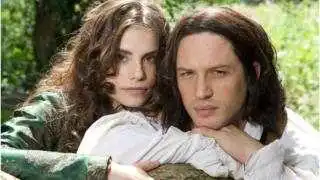 Image copyright ITV/REX/Shutterstock
Image copyright ITV/REX/Shutterstock
Charlotte Riley and Tom Hardy starred in ITV's Wuthering Heights in 2009
Happy birthday, Emily Bronte.
The author was born on 30 July 1818 in Thornton, near Bradford, and would go on to write just one novel before her death 30 years later. That novel was Wuthering Heights.
The house where Emily was born is now a cafe serving 'nduja salami and mozzarella flatbread. Her literary sisters Charlotte and Anne and brother Branwell were born there too, but the cafe is simply named Emily's.
Two hundred years on, Emily Bronte's Wuthering Heights still means so much to so many readerswith the work continuing to inspire other artists. Here are a few of the ways her presence is still felt in the things we read, watch and listen to.
1. Kate Bush
The most famous tribute came in Bush's 1978 song Wuthering Heights, which captured the novel's haunting romance. It was Bush's breakthrough at the age of 19 and went to number one for a month.
Bush was first struck by a TV adaptation of Wuthering Heights before reading the book. "I was deeply affected by it, and decided I wanted to write a song about the incredible imagery," she said.
Her interest may also have been piqued by the fact she and Emily Bronte share a birthdayas well as being Emily's 200th birthday, Monday is also Kate's 60th.
The singer-songwriter returned to the subject earlier this month, writing a new poem titled Emily, which has been inscribed in stone on the wiley, windy moors.
2. The Handmaid's Tale
Asked on Twitter which book had changed her life, Margaret Atwood replied that it was Wuthering Heights, which she read when she was in 11th grade (aged around 16/17).
The Canadian author also told The Telegraph: "When I hit high school, I read Pride and Prejudice and Wuthering Heights, and developed what was, in those days before rock stars, a standard passion for Mr Darcy and Heathcliff."
One of Atwood's most famous novels, The Handmaid's Tale, has been turned into an acclaimed TV drama, and showrunner Bruce Miller recently revealed that Ofglen's real nameEmilyis in honour of Bronte.
3. Lily Cole
The actress, model and campaigner is now also a director, making a short film inspired by Heathcliff, the anti-hero of Wuthering Heights.
The film, titled Balls, is a modern reimagining of the first few months of the life of the character, who was found abandoned on the streets of Liverpool.
Asked why Bronte meant so much to her, she told BBC Breakfast: "The fact she wrote the book at a time when it was very, very difficult for women to be taken seriously and become authors. The fact she published it under a pseudonym has always intrigued me.
"We don't know very much about her, she really is a mystery. It's purely the bookthat's the reason I'm fascinated by her. That she created that work."
The film is part of Cole's role as the Bronte Parsonage Museum's "creative partner" for Emily's bicentenary. Her appointment caused a row, with author Nick Holland quitting the Bronte Society in protest that the figurehead for the birthday celebrations "was a supermodel".
4. Sylvia Plath (and Ted Hughes)
In 1961, Plath wrote a poem titled Wuthering Heights. Unlike Kate Bush, she wasn't re-telling Bronte's story, but instead used the imagery of the bleak moors to convey her own desolate state of mind.
Two years later, the American poet took her life at the age of 30.
She had been married to fellow poet Ted Hughes, who used his 1998 collection Birthday Letters to reply to some of her compositions.
That book included his own poem titled Wuthering Heights, in which he drew comparisons between Plath and Bronte, writing: "You breathed it all in/With jealous, emulous sniffings. Weren't you/Twice as ambitious as Emily?"
5. Kate Mosse (and 16 other authors)
To tie in with the anniversary, 16 authors including Sophie Hannah, Laurie Penny and Dorothy Koomson penned short stories inspired by Wuthering Heights for a compilation titled I Am Heathcliff.
The collection was curated by best-selling author and Women's Prize For Fiction founder Kate Mosse, who described Wuthering Heights in her foreword as "a novel that changes its character and colour with every reading, yet remains uniquely and absolutely itself".
Explaining the book's "ambitious and uncompromising" qualities, she wrote: "This is monumental work, not domestic. This is about the nature of life, love, and the universe, not the details of how women and men live their lives."
Other ways Emily Bronte has inspired...
There have been more than a dozen film adaptations in the UK, US and countries including India, Japan and Mexico. Sir Laurence Olivier earned an Oscar nomination for playing Heathcliff in 1939.
Timothy Dalton took the same role in 1970; Juliette Binoche and Ralph Fiennes starred as the doomed lovers in 1992; Tom Hardy was top of the bill in a 2009 TV version; and Kaya Scodelario was Cathy in Andrea Arnold's film two years later.
In 2003, MTV introduced its version, centred on a Californian rock musician Heath, while Sir Cliff Richard created and starred as Heathcliff in a major stage musical in the mid-1990s.
And the story was spoofed by Monty Python's Flying Circus, who famously showed Cathy and Heathcliff using semaphore to communicate across the moors in a 1970 sketch.